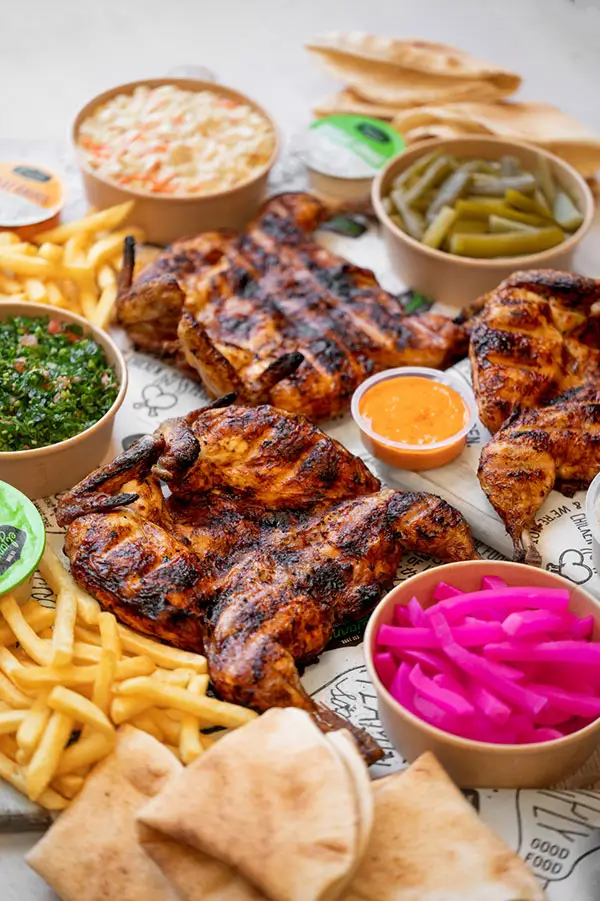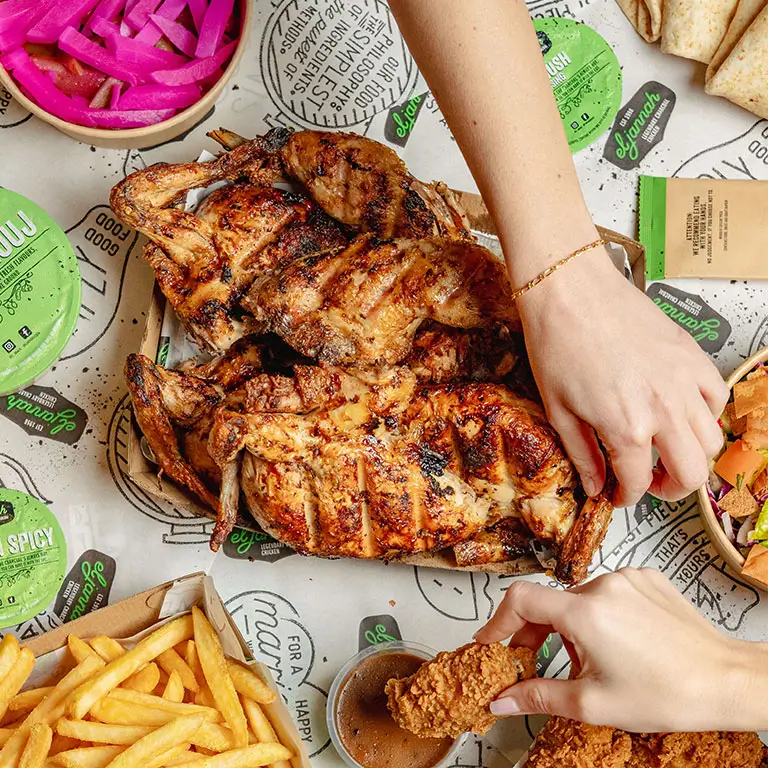Some people think chicken is simply a matter of life and death. To us, it’s more important than that, habibi. We don’t just love charcoal chicken: we live for it. The warm, amber glow of hot coals; the faint scent of charred meat and billowy clouds of smoke rising into the air. The distant hum of laughter mixed with crackling fire. This is charcoal chicken as we know it; not just cooked, but crafted.
At El Jannah, charcoal chicken is our heritage and our obsession. It’s in our DNA (and, given how much we eat it, probably our blood, too). But we get it, if you didn’t grow up with it, you might be wondering what all the fuss is about. Consider this your official invite into our world.
We’re taking you on a journey—from its origins in the Middle East to the way it’s been embraced (and devoured) across Aussie suburbs—to show you exactly why this isn’t just food. It’s family, heritage and fire-kissed flavour all rolled into one.
And if you think we’ll stop there? Not a chance. This guide links out to all the juicy stuff: how it’s made, how it compares, and why we’re still bragging long after the last bite. Trust us, we’ve been told to shut up about it more than once.
What Makes Charcoal Chicken Unique?
Let’s be real for a sec: not all chicken is created equal. Devastating, we know. But some of it’s dry. Some of it’s tough (have you ever tried overcooked chicken breast? It’s like eating a tyre!) Some of it’s somehow soggy. And you know what? Sometimes, it just tastes like it gave up halfway through cooking.
And then, there’s charcoal chicken.
*Cue the spotlight. The slow-motion pan. The angelic choir in the background*
Charcoal chicken doesn’t just arrive (how lame)—it descends. Golden, glistening, cloaked in smoke and smelling like salvation. It’s the main character. The Beyoncé of birds. The flavour heavyweight. You don’t just eat charcoal chicken. You tear, you dip, you wipe your mouth with pita and go back for more.
Unlike other cooking methods (we’ll get to that in a second), charcoal grilling locks in the juiciness and gives the chicken that crispy, smoky finish you just can’t fake. Real flames = real flavour. If you’ve never experienced the flavour before … you’re missing out and we’re sorry for your loss. Never fear, though, cause wallah, habibi, we’re here to fix that for you.

Charcoal Chicken vs Other Cooking Methods
Look, we’re not saying throwing your bird on hot coals is the only way to cook chicken. We’re just saying, once you’ve had it this way, everything else kinda feels like settling. But hey, we’ll let you be the judge of that. Here’s how other cooking methods stack up against the OG.
| Metric / Factor | Charcoal Chicken | Fried Chicken | Grilled Chicken | Rotisserie Chicken | Wood-Fired Chicken | Smoked Chicken | Air-Fried Chicken | BBQ Chicken |
|---|---|---|---|---|---|---|---|---|
| Cooking Method | Charcoal-grilled over hot coals, slow heat | Deep-fried in oil | Cooked on flat grill or gas flame | Slowly roasted on a rotating spit | Cooked in a wood-fired oven | Cooked slowly with wood smoke | Cooked with circulating hot air | Cooked on a gas or electric barbecue |
| Texture | Charred edges, smoky, tender inside | Crispy coating, denser meat | Evenly cooked, lean, less smoky | Moist, evenly cooked | Varies by wood type, crisp/charred edges | Moist, sometimes dry if over-smoked | Crispy skin, lean texture | Firm, evenly cooked, light char |
| Flavour Profile | Smoky, rich, deep flavour | Salty, oil-forward, heavy | Mild, clean flavour, less smoky | Savoury, uniform flavour | Subtle wood-smoke flavour | Very smoky, can overpower | Light seasoning, low-oil flavour | Grill flavour, mild smokiness |
| Feel After Meal | Lighter, less greasy | Heavy, oil-forward | Light, but less flavour depth | Moderate — filling but not greasy | Moderate, depends on wood intensity | Heavy if strongly smoked | Very light, low-oil | Moderate — filling, less greasy than fried |
| Best With | Fresh salads, pickles, garlic sauce | Chips, gravy, slaw | Veggies, rice, lighter sauces | Family meals, gravy, bread | Rustic breads, roasted veg | BBQ sides, beer, tangy sauces | Health-focused sides, steamed veg | Classic BBQ sides (corn, coleslaw, chips) |
| Sharing | Whole chicken & family packs | Buckets & combo meals | Typically single portions | Family-style portions | Shared plates, rustic settings | Often sliced or pulled for sharing | Single serves, portion-controlled | Shared BBQ plates or casual gatherings |
| Energy (per 100g) | 700–950 kJ (≈170–225 kcal) | 900–1300 kJ (≈215–310 kcal) | 600–850 kJ (≈145–200 kcal) | 650–900 kJ (≈155–215 kcal) | 650–950 kJ (≈155–225 kcal) | 700–1000 kJ (≈170–240 kcal) | 500–750 kJ (≈120–180 kcal) | 700–950 kJ (≈170–225 kcal) |
| Total Fat | 6–12 g | 13–22 g | 4–9 g | 5–10 g | 5–10 g | 6–14 g | 3–7 g | 6–12 g |
| Protein | 20–26 g | 16–22 g | 22–27 g | 20–25 g | 20–26 g | 18–24 g | 20–28 g | 20–26 g |
| Sodium | 250–420 mg | 350–650 mg | 200–350 mg | 220–400 mg | 220–400 mg | 300–600 mg | 200–350 mg | 250–420 mg |
Mastering the Method — Why the Process Matters
Legend says that if you burn the chicken, Tayta appears in the smoke with a wooden spoon. We’re not saying it’s true or anything, we’re just saying it hasn’t happened to us. When it comes to cooking charcoal chicken, our process isn’t just refined; it’s inherited, argued over, perfected and seared into muscle memory.
From marination to final flip, here’s how we honour the method that’s fed generations (and survived a thousand unsolicited opinions).
Why Marination Matters in Charcoal Chicken
When it comes to mastering legendary chicken, patience is the name of the game. You can’t rush flavour. We let our birds soak overnight until all the flavours essentially pack their bags and move in.
What’s in our marinade, you ask? Dreams. Regret. Generational bragging rights. The rest isn’t for you to know, because some things are sacred. We admire the tenacity, though, so nice try. If you’re whipping up your own marinade at home, you can’t go wrong with a good glug of olive oil, a hit of citrus, plenty of garlic, and whatever herbs you swear by.
The Science of Cooking Over Coals
Let’s get scientific, baby. The charcoal coals surround the chicken with radiant warmth, cooking it evenly from every side. Meanwhile, the smoke slides on in, fusing with the marinade and layering on that deep, can’t-fake-it flavour. It’s kinda like a slow and steady kiss. Are we being too sensual here?
Fresh vs Frozen Chicken in Charcoal Cooking
Fresh vs frozen? Please. It’s not even a contest. Frozen chicken can cook unevenly (especially when it’s not completely thawed), turn rubbery and taste like disappointment. Juicy? Frozen chicken has never met her.
You’ll never catch us cooking frozen chicken. We only cook fresh birds up in here, prepped daily in-store to max out the juiciness of every piece. It’s part of our commitment to quality. We’ve got you, habibi.
Why Real Coals Beat Gas Grills
When it comes to getting that signature smoky flavour, real coals beat gas grills, hands down. Gas grills tend to focus heat in a few spots and don’t impart the smoke throughout the chicken the same way that coals do. Never settle for second best, habibi.



The Emotional Pull of a Shared Chicken
Sure, smashing a chook solo hits the spot, but let’s be honest, it hits harder when you’re passing it around the table. Good food pulls people together, and charcoal chicken is Exhibit A. There’s science behind it, too! Eating together sparks oxytocin and syncs people up. Crazy right? But it’s why the laughter’s louder, the food tastes better, and everyone feels a little closer – and that’s exactly the point. It turns a simple meal into a memory that lingers long after the table’s cleared.
The Cultural Significance of Charcoal Chicken
Charcoal chicken lit its first flames in the Middle East long before it became a global obsession. In Lebanon, grilling chicken over hot coals is a ritual: a way of gathering, of honouring tradition, of celebrating hospitality. All of it is a reflection of food culture that’s built on generosity and connection.
When Lebanese immigrants brought charcoal chicken to Australia, it became both a taste of home and a gift to their new communities. What started as a family tradition carried across oceans has grown into one of the country’s most beloved comfort foods—one that now belongs to both Lebanese culture and Australia’s multicultural table.
Is Charcoal Chicken Healthier Than Other Takeaways?
Wondering if charcoal chicken’s healthier than other takeaways? Here’s how the different types of takeaway chicken compare.
Type | Oil Content | Nutrient Retention | Cooking Process |
Charcoal chicken | None or little | Nutrients are retained, as the lower heat keeps them locked in | Marinated, then cooked low and slow over flaming charcoals |
Fried Chicken | Lots of extra oil | Proteins and minerals are retained, while fat-soluble and water-soluble vitamins are lost in the cooking oil | Breaded, then cooked in piping-hot oil |
Roasted chicken | None or little | Most nutrients are retained, though B vitamins can be lost because of high heat | Marinated, then oven-roasted |
Get the full health lowdown (with zero spinach propaganda).
More Than Just Chicken — The Full Flavour Experience
Lennon without McCartney, Big Boi without André 3000, McGrath without Warne… some things just work better together. And that’s the case with our legendary charcoal chicken and our range of flavour-packed sides.
While our chicken is delicious on its own, we take it to the next level with our famous garlic sauce and sides like our tangy pickles, traditional Lebanese bread, and crunchy chips. You can never have too much of a good thing, and when you pair our chicken with our sides? Well, the world’s your oyster.
Discover the perfect pairings of sides and sauces.
When to Choose Charcoal Chicken
We can’t lie, we’re biased. If we could eat charcoal chicken for breakfast, lunch, and dinner, we would. However, there are plenty of situations where charcoal chicken is 100% the right move, if you’re trying to keep the whole crew (or just your cravings) satisfied. From a casual dinner for one, where the cooking’s taken care of for you, to trying to pack in protein after a hectic gym sesh, you can’t go wrong with one of our meals. Get those gains, Habib!
Got a few mouths to feed? When the (notoriously picky) in-laws are coming around, we’ll save your skin. You can even tell them it was you who cooked; we don’t mind.
Whether it’s a family gathering or a sports night where the whole club’s celebrating a successful (or not-so-successful) season, we’ll keep the vibes high with our legendary charcoal chicken and unforgettable sides. We can’t help with the banter, though. That’s on you.
The El Jannah Promise
Here at El Jannah, we’re fanatical about our charcoal chicken. Every bird is cooked to taste exactly like we remember from childhood: fresh, smoky, juicy and unforgettable. No shortcuts, no compromises. Our ancestors wouldn’t forgive us anyway.
So, whether you’re rolling in with a crew of die-hard charcoal chicken fans or trying it for the very first time, we’ll show you what real Lebanese hospitality tastes like. Fresh, fiery, and served with toum. Always.
FAQ's
Is charcoal chicken healthier than fried chicken?
Yep. Fried chicken swims in oil and crumbs, soaking up fat and calories. Charcoal chicken cooks over flames. It’s juicy and smoky without the grease bath.
Why does charcoal chicken taste smoky?
Call it magic (or chemistry), but the smoky taste of charcoal chicken comes from the flaming charcoals. Fat and juices drip onto the coals, creating a smoky vapour that infuses into every part of the chicken.
What are the best sides to pair with charcoal chicken?
Easy: garlic sauce (non-negotiable), hommous, zingy pickles, tangy taboulli and chips, all stuffed into a fresh piece of Lebanese bread.
Does charcoal cooking make chicken dry?
Not when it’s done right. Coals cook low and slow to lock in moisture. The result? Chicken that’s crispy on the outside, juicy on the inside.
Can you reheat charcoal chicken?
For sure. Wrap it in foil and pop it in the oven or air fryer to keep it juicy. Just … skip the microwave. It dries it out, and dry chicken is a crime.
